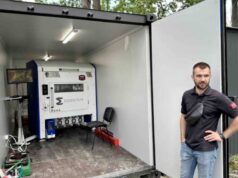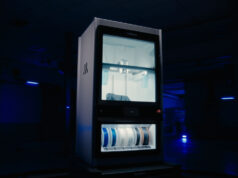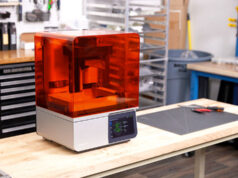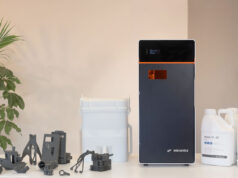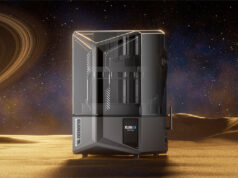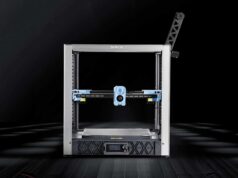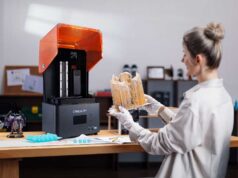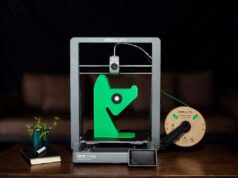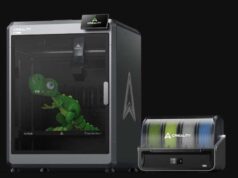Das Unternehmen mUVe 3D, bietet auf Indiegogo mit dem mUVe 1 einen Laser “Stereolithografie” 3D-Drucker.
05.04.2013 – Der mUVe 1 3D Printer, erstellt physikalische Objekte, indem ein digitales 3D-Modell mit einem Laser, Schicht für Schicht, in ein Bad aus flüssigen UV empfindlichen Harz zeichnet. Mithilfe dieser Technologie können üblicherweise (abhängig von der Lichtquelle) äußerst detailgenaue Objekte erzeugt werden. Der mUVe 1 ist Open Source.
Technische Spezifikationen:
- Bauraumgröße: 14,5 x 14,5 x 18,5 cm
- Auflösung: 0.1 mm
- Laser: 405nm Laser
- Gerätegröße: 33 x 33 x 45 cm
Der mUVe 1 wird aktuell auf der crowdfunding Plattform Indiegogo ab $999 (ohne Versand-, Zollkosten, aber mit 500ml Druckmaterial) als Bausatz angeboten.
In letzter Zeit gab es bereits einige Projekte für derartige “resin-based” Eigenbau Projekte. Derartige Projekte sind beispielsweise der sLAMPS, Ilios 3D-Drucker, Lunavast 3D Printer, Miicraft 3D Drucker, Junior Veloso 3D Printer, B9 Creator, Sedgwick Open Source 3D DLP Printer und der Acme Design Monolith.
(c) Picture & Link: Dean Piper via Indiegogo
Update: 28.06.2013 – Baupläne veröffentlicht
Dean Piper hat nun die Baupläne des mUVe 3D-Druckers veröffentlicht. Die Pläne können auf der offiziellen Seite gefunden werden.
Update: 12.02.2014 – mUVe3D veröffentlicht Marlin Firmware Update
In Zusammenarbeit mit Tim Schmidt und dem Lansing Makers Network entwickelte mUVe 3D eine neue Marlin Firmware speziell für den Einsatz mit dem Stereolithografie Verfahren (SLA). Neben den häufig verwendeten Fused Filament Fabrication (FFF) Verfahren unterstützt die Marlin Firmware nun auch die Steuerung eines Pulslasers mithilfe dessen das flüssige Photopolymer zu einem 3-Dimensionalen Objekt ausgehärtet wird.
“If all goes well then the Marlin community will accept our changes and it will get rolled into the standard Marlin firmware. Then deciding the type of machine it controls will be as simple as changing a few options before compiling. It will truly be the all-in-one solution for 2 axis and 3 axis machine control.” so Dean Piper, Gründer von mUVe 3D.
-mUVe 3D specific peel move still exists and is a function that can be turned on and off before you compile, so now you can use the firmware on other SLA based machines without edits.
-Use hardware other than Arduino Mega 2560 and RAMPS, you can select the machines on the list that have enough memory to install it. It has grown in size, chips with less memory may be an issue but this hasn’t been investigated yet.
-Firmware defined laser point size for future features such as W/cm^2 calculation and auto-laser-power setting for resins with W/cm^2 data available.
-EEPROM saves the amount of time the laser has been on and will tell you when you boot how many hours and minutes the laser has been used.
-PPM laser pulsing with specific maximum frequency set in Hz.
-Laser pulsing built right into stepper code so there is no added processing time, delays, or otherwise. Full speed printing.
-Configurable laser power on a scale of 1-100.
-Configurable pulses per mm, default of 10.
-Configurable time on for each laser pulse in microseconds, default is 3000.
–Default connection speed lowered to 115200 for compatibility with more computers.
–Built on and compiles with the latest version of Arduino, main file is now Marlin.ino.
die neue Firmware kann auf der muve3d Webseite geladen werden.



